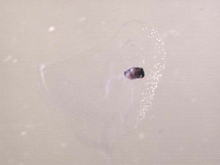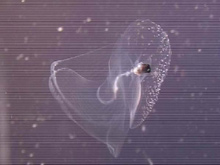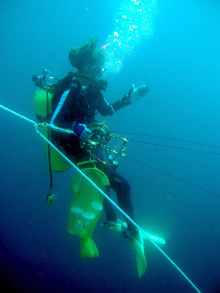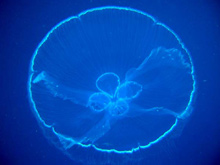
During the mid-day dive, the submersible team had a strange encounter with a swordfish. Just as they switched on the video recorder, 1,760 ft below the surface, the large fish suddenly appeared in the distance. It swam directly at the forward observation sphere of the Johnson-Sea-Link before veering away.
![]() Click here to see this swordfish in motion and read further details.
Click here to see this swordfish in motion and read further details.
Tricks of Vision, Prawns in Space
August 12, 2004
Justin MarshallMarine Biologist
Vision Touch and Hearing Research Center
Queensland Brain Institute
University of Queensland Australia
Traveling all the way from Australia to spend 10 days in the Gulf of Mexico on a bouncing vessel is not everyone’s idea of fun. For me it is a fantastic opportunity to pursue my current obsession: how do other animals see, and what does their world look like to them? What has drawn me here (away from the Great Barrier Reef and beautiful beaches of Queensland) is the unique technology aboard R/V Seward Johnson II and the possibility of extending my research to the deep oceans and blue open waters of the gulf.
Here, in 1,000-2,000 ft water, life poses the same basic problems as it does in the dense, colorful throng of the reef: how to eat, breed, and not be eaten. The key differences in the gulf are the increased distance between animals and (except close to the bottom) the lack of a solid background. Both these features of the open, deep-water environment make detection and hiding the biggest issues for life here. What "tricks" of vision and camouflage do animals in this environment employ to allow them to survive?
The answer can be found by talking to the most seasoned of the seas, the fisherman. All fishermen know about polarized light. They use polarizing sunglasses to help see through the confusing glare of water to the fish below. We are discovering that many animals living in this open ocean realm have known this trick for millions of years. My desire to find out exactly how they do this has brought me here to Operation Deep Scope.
Unlike the fisherman, who must see through water surfaces, oceanic animals need to see through the scattered rippling light of the ocean depths. The problem is similar to that faced by the fisherman. Both humans and fish extinguish polarized light from the environment by filtering, or preferentially receiving, polarized light from the surrounding environment. This trick enables a clearer view that extends further into the distance, a real advantage for spotting prey or mates and avoiding predators.
Adaptations of the eye -- such as polarized light vision, color vision, and the highly sensitive vision needed by deep-sea animals -- are what motivate me. On the Great Barrier Reef, color is a currency of animal language. The color signals given off by fish and crustaceans living there have formed the basis of my research for the past ten years. Polarized light is used there, as some reef animals use specific polarized signals to talk to each other. I am now using the Johnson Sea-Link submersibles and blue-water diving possibilities from the Seward Johnson II to investigate tricks of vision in the Gulf of Mexico.


A mid-water gelatinous mollusk seen using polarized light. The two images are successive video frames taken with a modified camera that, for alternate frames, uses and then removes a polarizing analyzer filter. Click image for larger view and further details.
The week, before coming to the United States, I was in the field in Australia using another form of complex technology -- satellite and airborne sensors to take images of the earth. Satellites and submarines have common ground in nature’s technology, and I aim to put prawns in space (or at least the principles behind their visual systems). By studying the tricks that animals, such as prawns (shrimps) and fish, have been using for millions of years to see the earth, I hope to improve the way we see our planet and monitor its health.
Analyzing color and seeing more clearly with polarization are both ways to monitor health. The Gulf of Mexico has a dead-zone the size of Rhode Island, the result of human impact. The Great Barrier Reef has 50-70 yrs of life before disease and reef-bleaching reduce it to the same rubble seen on the once-beautiful reefs of Florida. By learning about the wonders of nature, by sharing this beauty with others, and by using animal vision to better visualize and monitor our planet, I hope to help preserve what we have for the future.
Sign up for the Ocean Explorer E-mail Update List.

























